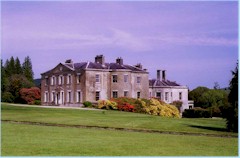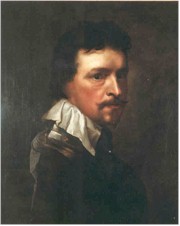Coollattin House
Wednesday, January 6th, 2010
Coollattin House, Co. Wicklow
The history of the Wentworth/Fitzwilliam family in England has been well documented (see our historical overview for a brief summary), but what is less well known is the influence they had on the history of Ireland. As well as the family seat of Wentworth Woodhouse they owned another large house called Malton House (later Coollattin House) in County Wicklow from where they managed their 88,000 acres of Irish lands. They also acquired a number of Irish titles and political positions over the years.
Acknowledgements
Our Coollattin article has been produced thanks largely to the contributions of Jerry Cassidy of Shillelagh who is involved with the golf club who now own and are responsible for the upkeep of the modern-day Coollattin House. Jerry has collected a vast amount of information about the Fitzwiliam family’s presence in the village and in Ireland in general; our thanks to him, and we hope that the articles will be of interest to residents of Wentworth and Shillelagh alike. Should you wish to contact Jerry for further information about Coollattin you can e-mail him at [email protected].
The Wentworths and Fitzwilliams in Ireland
The Early Wentworths
Thomas Wentworth, 1st Earl of Strafford (b. 1593, beheaded 1641), is famous for the part he played in the events leading up to the English Civil War, but prior to this he also played a significant role in Irish history.
 A close adviser to King Charles, Strafford was appointed Lord Deputy of Ireland in 1633. He set about the job with the aim of creating greater prosperity in Ireland and thus (he hoped) greater loyalty to the English Crown. His methods, however, left much to be desired and there was considerable local resentment about the way in which he manipulated the Irish parliament and appropriated lands in the name of the Crown, ostensibly to better the economy of the country by encouraging the English nobility to take up residence there.
A close adviser to King Charles, Strafford was appointed Lord Deputy of Ireland in 1633. He set about the job with the aim of creating greater prosperity in Ireland and thus (he hoped) greater loyalty to the English Crown. His methods, however, left much to be desired and there was considerable local resentment about the way in which he manipulated the Irish parliament and appropriated lands in the name of the Crown, ostensibly to better the economy of the country by encouraging the English nobility to take up residence there.
Strafford himself purchased the half barony of Shillelagh in 1635 and built a hunting lodge and park (Fairwood) near Coollattin. There are records of his writing to King Charles about the wonderful countryside and hunting in the area, although it is likely that the local O’Byrne clan, whose lands he took over, were less than enthusiastic about his presence in the area.
The remains of Strafford’s hunting lodge and surrouding fortifications still exist at a site know locally as “Black Toms Cellar”. The Earl acquired the nickname “Black Tom” as he was regularly seen in the area wearing black armour and riding a black horse; there is also a “Black Tom’s Tavern” in nearby Tinahely.
Strafford’s son William 2nd Earl of Strafford (1626-1695)went on to build up the family estates in Coollattin. The area is famous for its oak woods and its timbers were sold for use in the construction of Westminster Hall in London as well as parts of Westminster Abbey, King’s College Chapel, Cambridge and the Stadt Hosue in Amsterdam. Even accounting for the higher shipping costs, the cost of felling and preparing timber in Ireland worked out at half the price of producing comparable timber on the Wentworth estates, hence the family’s involvement in the area continued to grow.
On the death of the 2nd Earl the estates passed to his nephew, Thomas Watson Wentworth (1665-1725), whose son Thomas Wentworth, Earl of Malton and 1st Marquis of Rockingham was the father of Lady Ann Wentworth was to go on to unite the Wentworth/Fitzwilliam lines by marrying 3rd Earl Fitzwilliam.
The Early Fitzwilliams
The history of the Fitzwilliam family in Ireland starts with Sir William Fitzwilliam, 1st Earl of Milton (1460-1534). A successful merchant and Alderman of London, Fitzwilliam made numerous land purchases, including the family’s first estates in Ireland. Unlike many other aristocrats of the time Fitzwilliam seems to have built up his fortune by honest hard work and gained significant respect from his peers.
Fitzwilliam’s grandson (also Sir William Fitzwilliam) was the first family member to have significant political influence in Ireland. He was made Lord Deputy of Ireland (shortly after Thomas Wentworth, Earl of Strafford) and was Commander in Chief of the Army. He seems to have lasted longer in the post than Strafford and as a reward his family was granted yet more Irish lands by the King.
By 1620 the family had been granted the title Baron Fitzwilliam of Liffer (the first holder being yet another Sir William Fitzwilliam, great-great-grandson of the 1st Earl) and then in 1716 the 3rd Baron Fitzwilliam (who, as you’ve probably guessed, was also called William) was created 1st Earl Fitzwilliam of Ireland.
The 1st Earl’s grandson (William again!) was not only 3rd Earl Fitzwilliam of Ireland but also became 1st Earl Fitzwilliam of England following his marriage to Lady Ann Wentworth, daughter of the Marquis of Rockingham and heir to the Wentworth Estates, including Wentworth family’s significant Irish landholdings.
The 4th Earl Fitzwilliam of Ireland
William Wentworth Fitzwilliam, the 4th Earl Fitzwilliam of Ireland (or 2nd Earl Fitzwilliam of England) was the first heir to the combined Wentworth/Fitzwilliam family fortune.
It was the 4th Earl who built Collattin House (it was originally called Malton House, presumably after one of his grandfather’s titles as the Earl of Malton). The house was designed by the leading architect John Carr, who was also responsible for the grandiose “stable block” at Wentworth Woodhouse as well as the Keppel’s Column and Mausoleum monuments near Wentworth.
The building was started around 1794 but before completion it was burned down in a rebellion in 1798 (along with 160 other houses in the nearby village of Carnew and several Catholic churches). It isn’t clear if the house was burnt to the ground, but on Lady’s Day in 1798 a carpenter was paid £27 7s 5d and a half pence, even though his work had apparently been destroyed by the rebels. Work resumed again in 1800 and the house was completed in 1807.
As well as rebuilding their house and the village, the Fitzwilliams contributed to the repairs of the Catholic Churches and gave land for other churches (whilst other landlords would not even allow a Catholic church on their estate). Throughout the family’s time in Ireland they did not take sides in the various Irish struggles through the centuries, and perhaps as a consequence their house was left untouched in the last dash for independence.
Around 1780 the Earl sent over an instructor in ploughing from Wentworth to train his Irish tenantry. In 1812 someone called Wakefield wrote “His estate is the best cultivated of all I have seen in Ireland”.
As well as undertaking building and agricultural projects, the 4th Earl was also Lord Lieutenant or Ireland for a short time in 1795. Knowing of the family’s strong Irish connections and relative local popularity, Prime Minister Pitt had sent the Earl to Dublin telling him to appease the Catholic leaders of the day.
On arrival in Dublin, Fitzwilliam set about dismissing senior officials with strong Protestant connections, including Beresford the Commissioner of Customs. This apparently backfired as Beresford then appealed above Fitzilliam’s head directly to Pitt who ordered the reinstatement of the officials; inevitably Fitzwilliam then resigned. Apparently Fitzwilliam’s departure was seen as a major setback by the local population who closed all the shops in Dublin on the day he left, almost as if in mourning. Fitzwilliam and Beresford later met at the Tyburn Turnpike in London for a duel (which fortunately was stopped by the local constable!).






